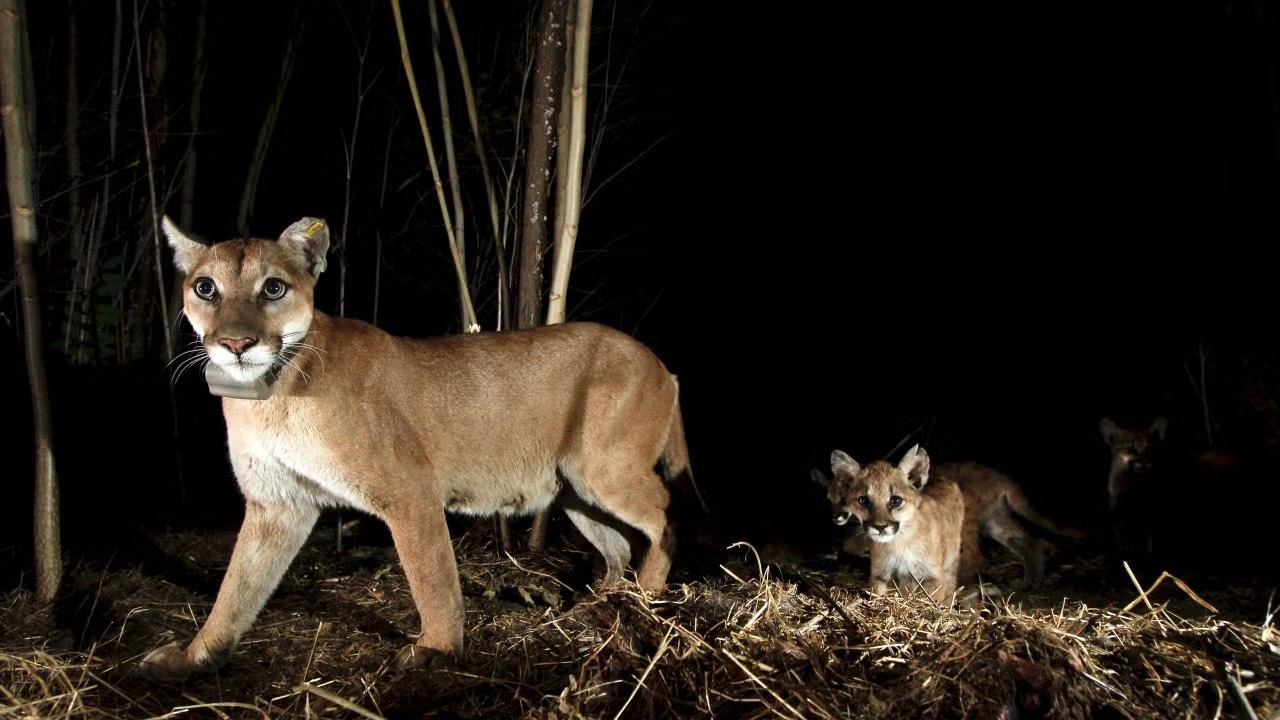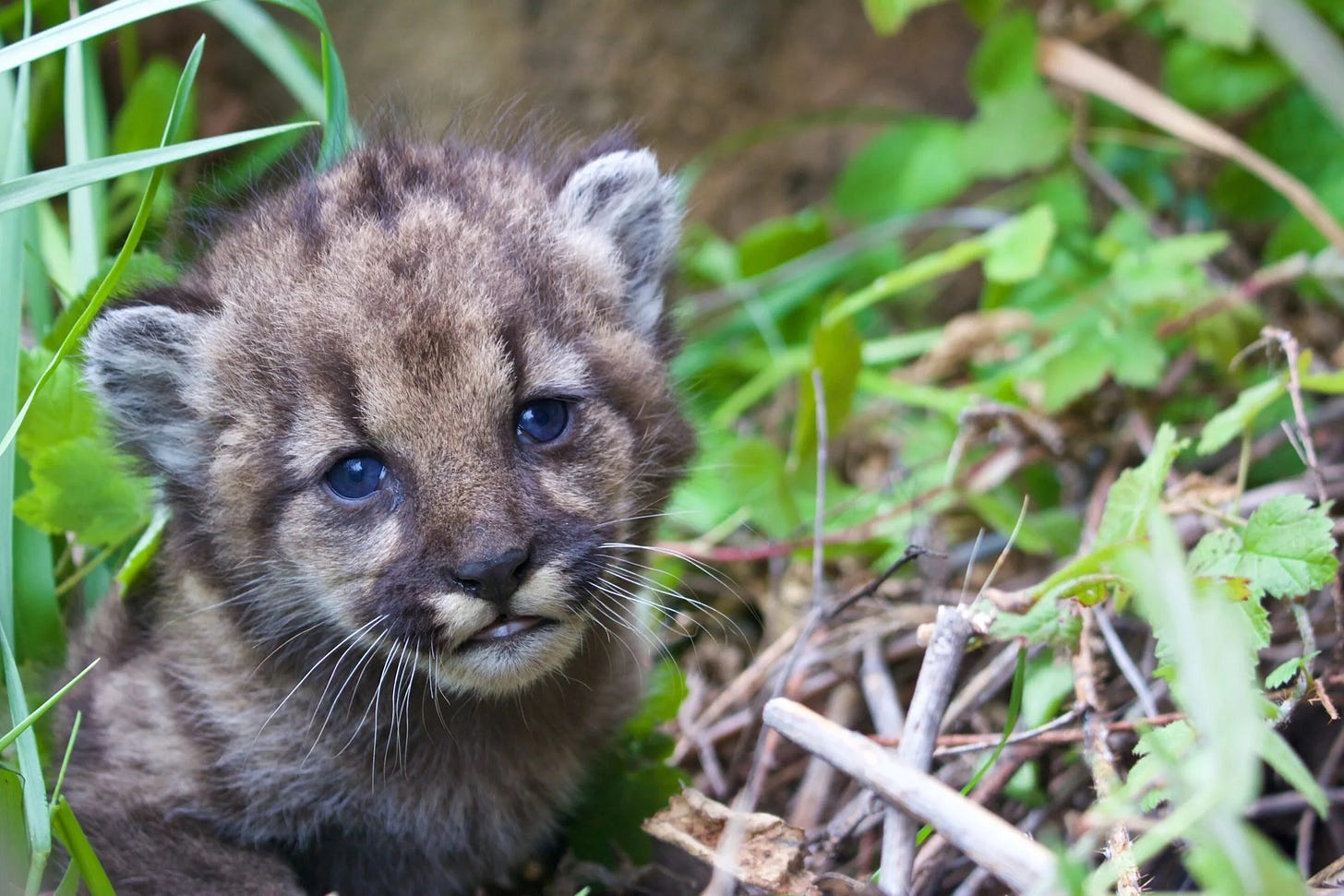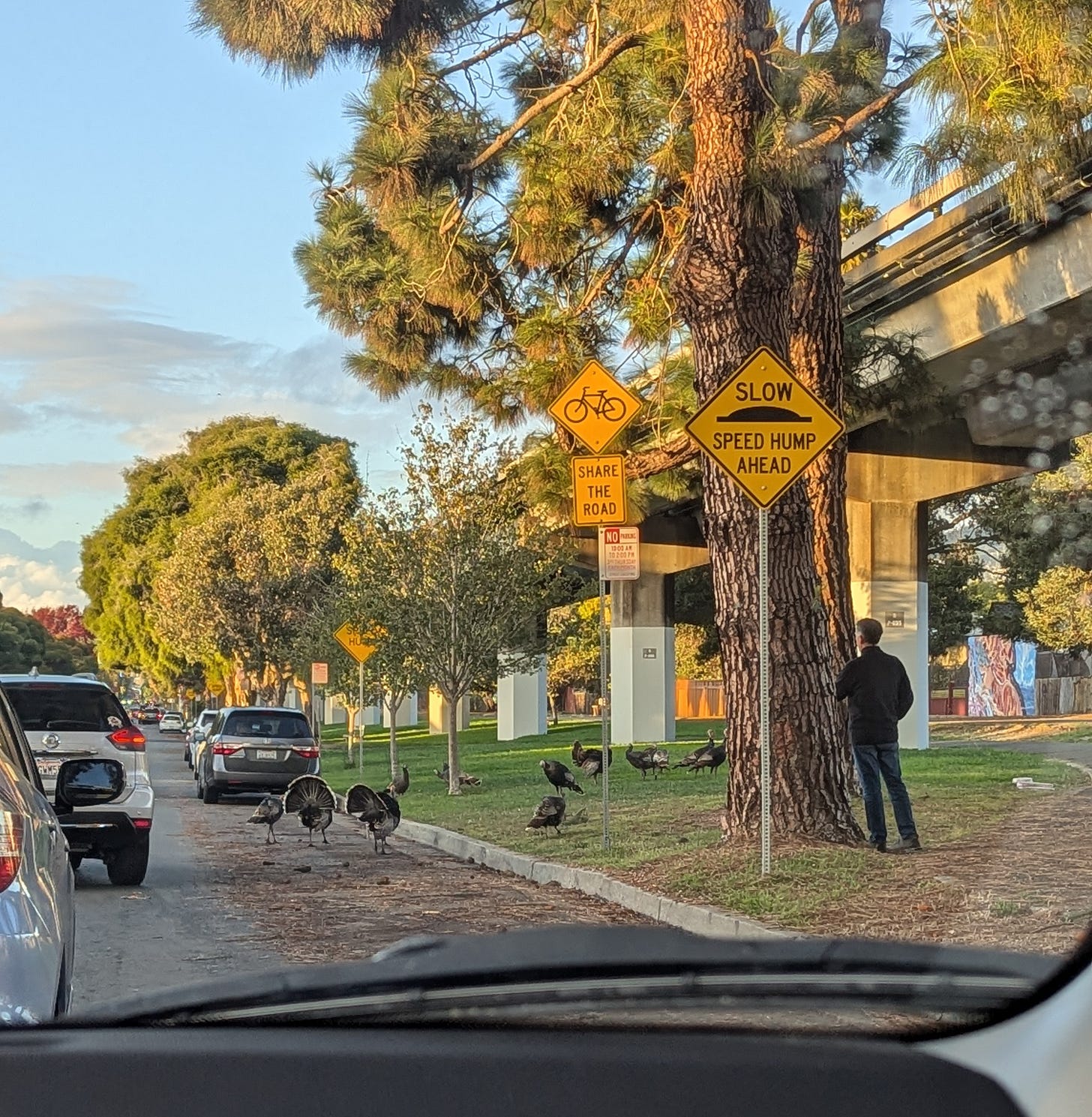Why did the cougar cross the road?
... Because humans built it a bridge. Wildlife crossings throughout the world are saving lives, from tortoises to elk, and koalas to crabs. Plus, a bat celebration.
Recently, the Los Angeles Times reported that “the world’s largest wildlife crossing is finally standing.” The structure spans 10 car lanes but won’t be complete until 2026.
The $92 million project comes 35 years after a biologist first noted that mountain lions in the area were too genetically isolated, having been boxed in by highways for decades. In addition to cougars, the bridge will allow deer, bears, coyotes, foxes, bobcats, skunks and badgers to avoid 300,000 cars per day.

The wildlife crossing was inspired by P-22, a lone male mountain lion who gained fame roaming the Hollywood hills and wandering the backyards of millionaires. Consequently, a third of the crossing’s funding, or $34 million, came from philanthropists and celebrities.

Great news: More crossings are coming. States like New York are taking advantage of $350 million from the Bipartisan Infrastructure Law that was dedicated to wildlife crossings. It’s a win-win for wildlife and for people. Collisions with large animals take lives, both human and animal, and cost billions each year.
Crossings started in France in the 1950s and have spread across Europe. Over 1,500 wildlife-only bridges and underpasses in America are reducing vehicle collisions by 80 to 97% percent. Australia has saved koalas with crossings. In Banff National Park in Canada, dozens help grizzlies find mates. Sonoran desert tortoises have been spotted waddling across bridges and underpasses in Arizona.
There’s even a bridge in Australia for red crabs! These critters spend three months a year migrating up to 10.5 miles (17 km) from the rainforest to the ocean.
In 1975, Utah became the first U.S. state to build a crossing and now has over 60. A $5 million bridge over Highway 80 in Utah’s Parleys Canyon has reduced wildlife-vehicle collisions 90 percent on a stretch of road that once saw over 100 collisions over a two-year period.
“We’re amazed. We thought it would take a few years for the animals to recognize it was there,” John Gleason with Utah Department of Transportation told Fox 13. “When you … recognize that each one of those animals could potentially cause a crash on our roads, it’s keeping people safe; it’s keeping animals safe.”

Check this out: a compilation of all the wildlife using the Parley’s Canyon Overpass includes moose, bear, porcupine, squirrel, marmot, deer, cougar, bobcat, coyote and fawns.
But that’s a lot of money
Still, some readers might question why any society should spend so much money on wildlife. Consider this: On average, 200 people die in these wrecks each year in America. Per year, cars hit a million large animals. Annually, this costs Americans $10 billion in property damage, emergency services and medical bills.
Those are the human costs. Adding up the smaller animals amounts to a million vertebrates per day killed on American roads.1 One car can counteract conservation efforts totalling millions of dollars and decades of efforts. This year alone, 12 of Florida’s critically endangered cougars, out of a population of only 120 to 240, were killed in vehicle collisions.
Colorado has built more than 60 crossings, the most of any U.S. state. Busy Interstate 80 bisects it, smack dab in the middle of migratory routes for thick herds of deer, elk and pronghorn. In this state, collision costs add up to $80 million a year.
In Idaho, the state’s first wildlife crossing is commemorating its first year, during which not one vehicle collision occurred.
From local TV station KTVB:
Around 9,000 mule deer and 2,400 elk cross that exact stretch of Highway 21 with their migration patterns – leading to serious collisions on the road.
"The animals are going back and forth all through late fall, winter and early spring, before they go back to their summer or winter habitat,” [planner Scott Rudel] said.
Nobody wins when a vehicle hits a large animal like an elk, moose or mountain lion.
In the Great Smoky Mountains, Hurricane Helene recently damaged Interstate 40, destroying a vital connection between Tennessee and North Carolina. Advocates who were already lobbying for wildlife crossings say this is the perfect time to rebuild better.
From Knox News:
“If we want to look for silver linings, I think there is a chance that we could use this long pause in traffic on I-40 to create some win-wins for wildlife, driver safety and flood resilience along the road,” said Ron Sutherland, chief scientist for coalition partner Wildlands Network.
So, why do animals cross roads?
food
water
shelter and safety
nicer weather
new mating options (Can’t we all understand the desire to snuggle up with someone who’s not a cousin?)
Lion P-22 was loved by millions, but never found a mate. He crossed two enormous highways to make it into the large park where he lived in downtown Los Angeles for over a decade. He was euthanized in 2022 after being captured, examined and found to have sustained skull fractures in a recent run-in with a car.
Here’s to the new generation of mountain lions near Los Angeles fairing better than that.

Not all roads are killers, say Yolo Causeway bats
I was driving through Sacramento a few weeks ago, speaking on the phone with my father, hands-free, when a quarter million bats emerged from under the road. I’d heard about these bats for a while, but had never been present those few minutes before dusk that are the perfect time to see them.
A cloud of bats is as breathtaking as a murmuration of starlings. And there I was, right in the center of it. Swift ribbons, like smoke, unfurled across the blazing pink sky, trailing endlessly out from under me. More and more and more bats, together swirling and rising, endlessly dancing toward darkening skies.
I think my father had to take out his hearing aids, I was shouting so ecstatically about the bats.
The Yolo Causeway is a 3-mile raised highway that passes over floodplains used by migratory birds. The largest colony of Mexican free-tail bats in California roosts in the causeway’s warm expansion joints, emerging to fly up to 50 miles every night over farmlands and vineyards to the north and south of the capital. And, luckily, those same senses that help them hunt through the night mean they sure know how to steer clear of cars.
Speaking of bats,
has a wonderful new post on big brown bats, “Bats in Gotham,” where I learned that mother bats fly with their newborns. also writes frequently about bats for Bat Conservation International, most recently the Hawaiian hoary bat, the islands’ only native land mammal.Who’s thinking about turkey?
I started thinking about crossings this week because of
’s incredible turkey traffic jam photo in his recent essay, “Escaping into Nature.” Did you know turkeys are running around wild on an island in Europe?Here are some friends we encounter almost daily. They think nothing of cars. If you’re in the U.S., Happy Thanksgiving!
Hopeful headlines
From TRCP: Nevada Volunteer Project Brings Water to Desert Bighorns
Water is the limiting factor for wildlife in much of Nevada, and guzzlers have become a critical habitat improvement in arid climates. Guzzlers are human-made rain or snow collection systems that store water in a reservoir for wildlife to drink during drought. Many have been funded and built in the same way as this Churchill County project – through volunteers and donations.
From RadioIQ WVTF: Thousands of tourists flock to far Southwest Virginia to see wild elk
Elk used to live throughout the eastern United States, but European colonizers overhunted them and they went extinct in the 1800s. Since the 1990s, these 700-pound animals have been making a comeback in Appalachia, including in Far Southwest Virginia.
From The Associated Press: In southern India’s tea country, small but mighty efforts are brewing to bring back native forests
In a small mountain fold just a few hundred meters below the region’s tallest peak, native trees planted 10 years ago have grown up to 4.5 meters (15 feet) tall. A stream flows amid the young trees that replaced nearly 7 acres of tea plants.
“This whole place was tea plantations and this stream was not flowing throughout the year,” said Bosco, the ecologist. “Since we began our restoration work, it flows through the year and the trees and bamboo have grown well along the stream.”
From USA Today, how biologists saved the yellow-legged frog in Yosemite National Park and the High Sierra. I love all the stories I share, but I love this one in particular because of its descriptions of a “shower of frogs” splashing into lakes when early explorers approached. Over 150 years later, biologists never gave up trying to save them, even as they saw the frogs dying of disease and dwindling to near extinction over ten years.
'The lakes are alive again': These frogs are back from near extinction
For the past 30 years, Knapp and a tireless group of biologists have been scouring the few fish-free lakes left for remnant populations of the once iconic frog. Not only did they find a few, but over decades of observation they realized that in rare cases, the frogs were evolving resistance to the chytrid fungus.
From LiveScience: 'The prescription is nature': How satellites can show us the healing effects of nature
"The incidence of diagnosis and treatment of mental health disorders is less the greener the environment people live in."
About Earth Hope:
Earth Hope is a solutions-based journalism project that highlights environmental success stories from around the globe, because hope is the foundation of progress. I’m Amanda Royal, a former newspaper reporter and current eco-news junkie. Read more about this project and what inspired it.
Thanks for being here. 🙏🏻
Vertebrates are animals with backbones, such as snakes, mice, squirrels or raccoons. So, this number doesn’t include insects, which of course die in very high numbers on car windshields.








P-22 was a loss. But the crossover bridge in Agoura goes over the 101 freeway and now there have been sightings of mountain lions in Malibu Creek State Park as well as bears . In 2016 one young mountain lion duo kill a tend goat shepherd’s dog. The lion still roams. I believe there is another transit bridge that crosses the 215 freeway in Riverside County. That bridge was built earlier perhaps 2015? Your contribution to environmental protection journalism is very much appreciated. Glad to see crabs using a migration bridge.
I really like the proposed design for the Los Angeles crossing. It looks so much more natural and easier for wildlife, and it makes the highway look less... freeway-ey. Although maybe that'll just be from the side.